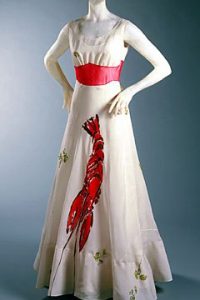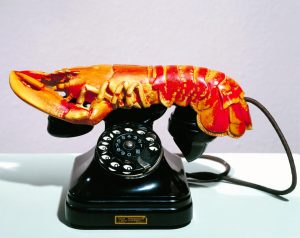Salvador Dali’s Lobster Telephone 1938 (Tate)
The Lobster Telephone is one of my all time favourite sculptures; Dali had this unique ability to make madness seem normal. I’ve always been fascinated by his creative process, and the fact that I’ve never questioned the absurdity of most of his work. With this piece I loved the use of the traditional rotary dial telephone and the pastel colour palette set off by this bizarre, vibrant shell fish. Its unexpected and original, the way that the tail echoes the curve of the phone create such harmony that it almost seems normal.
The Lobster phone was a collaboration between Dali and Edward James. Pairing the two unrelated objects was an attempt to reveal the secret desires of the unconscious, as well as having strong sexual connotations. On this particular piece Dali placed the tail (where the sexual organs are located) directly over the mouth piece of the telephone. He also created a multi media piece called “The Dream of Venus”, where he covered live models genitals with lobsters. In the same year Dali submitted a drawing of the same telephone with a lobster receiver but this time surrounded by flies, titled: ‘TÉLÉPHONE APHRODISIAQUE’. A similar drawing is printed in his book, captioned “I do not understand why, when I ask for a grilled lobster in a restaurant, I am never served a cooked telephone; I do not understand why champagne is always chilled and why on the other hand telephones, which are habitually so frightfully warm and disagreeably sticky to the touch, are not also put in silver buckets with crushed ice around them.”. Both lobsters and phones featured in a large portion of his work, but this particular piece was said to have saved the Surrealist movement. It resurrected an ageing art form and added excitement and energy
Elsa Schiaparelli’s Lobster Dress 1937 (Philadelphia Museum of Art)
Close friends Elsa Schiaparelli and Dali collaborated on many occasions, but their most famous piece was the Lobster dress. Schiaparelli asked Dali to paint one of his heavily featured lobsters on her dress, said to symbolise sexuality. Alongside the Lobster were sprigs of parsley, Dali apparently requested to slather real mayonnaise on the dress but undertsandably Schiaparelli would not allow it. Dali once said “Like lobsters, young girls have a delightful exterior. Like lobsters, they turn red when you get them ready to eat”. The white, silk dress symbolising virginity and innocence in contrast with the ginormous vivid red lobster created this dichotomy between classicism and exhilarating excitement. The fact that the lobster is painted right between the woman’s thighs makes one question the intention and meaning behind it.
The combination creates a sensual, fun garment that challenged their time. I love that Schiaparelli was one of the first to combine art and fashion, jumping straight into the surrealist movement. Unfortunately, while the dress became the pinnacle of Schiaparelli’s career, the erotic tension Dali aimed to create destroyed the purpose of Cecil Beaton’ shoot with Wallis Warfield Simpson. The dress was deemed too provocative and the photographs weren’t approved for public viewing.
Tate (2017) Salvador Dali Lobster Telephone 1938. Available from: www.tate.org.uk/art/artworks/dali-lobster-telephone/
Rogers, L.W.R (2009) Elsa Schiaparelli: Shocking-Pink. Available from: www.lisawallerrogers.com/tag/schiaparelli-and-the-lobster-dress/

